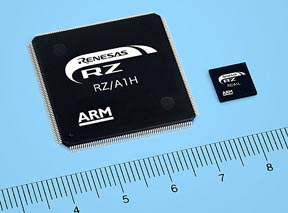Usually, I like to cover MCUs in this column – that is general purpose processors that have program memory (usually flash) on chip. But today we are looking at two CPUs (without flash) that I think are interesting for embedded applications.

Renesas CPU with graphics
The first is from Renesas, the 32-bit RZ/A1H CPU features up to 10 Mbytes of RAM, the largest capacity in the industry. This may not seem important, especially considering the IC has only boot flash, but think about a WXGA-resolution (1,280 × 768 pixels) graphics display application which, with this chip, needs no external RAM. Think about the ease of design, about the low noise without the fast data running on RAM bus, and about the performance gain from direct access RAM. Also consider not having to worry about changing RAM styles in the next few years.
Next, think about how prominent graphics displays are becoming. Every plant manager whose daughter is using an iPad to do her homework every night thinks the next multi-hundred thousand dollar machine they buy for their plant should obviously have high-res graphics displays, and touch as well. It's just required now.

The RZ/A1H CPU features up to 10 Mbytes of RAM.
Along with all that RAM, the RZ/A1H has a 400 MHz ARM Cortex-A9 processor, a two channel digital video decoder, a two channel video display controller, a display out comparison unit, HMI capabilities, a camera input, hardware accelerated graphics output, and OpenVG 1.1 and audio functions.
This LSI has a 32-Kbyte L1 instruction cache, a 32-Kbyte L1 data cache, and a 128-Kbyte L2 cache — which I'm told allows it to run from an external serial flash program memory. It also has a CAN port, an Ethernet controller a CD ROM controller, a 12-bit A/D converter, two 10-bit PWM channels, a I2 C bus and SPI interfaces, serial sound interface, media local bus, SCUX, USB 2.0, and SPDIF interfaces, a NAND flash memory controller. It has a JPEG codec unit, a capture engine unit, a pixel-format converter, a sound generator, an SD host interface, an MMC host interface, a motor control PWM timer, and interrupt controller modules.
A new Intel processor
And now for something totally different, we look at the new Intel Quark. Quark is a 32-bit processor SoC that makes the Atom CPU family all look big and high power. It is an obvious assault on ARM territory and targets all sorts of low-power jobs, but especially the famous Internet of Things (IoT). It is one-fifth the size of Atom and uses one-tenth the power. It is x86 instruction compatible. Initial chips will be built on a 32-nm process and run at 400 MHz.
The chip is synthesizable and customizable — a first for Intel. Intel would prefer that Quark chips (including those with custom, third-party blocks) be built on Intel's own fabs, but it will, in time, be buildable by third parties, after you license the core.
This SoC meets your embedded processor needs with secure boot, extended lifecycle support, extended temperature, and ECC. It also offers a lot of fast I/O capabilities via PCI Express and USB 2.0 interfaces, and has two Ethernet interfaces on chip, along with I/O intended to connect cellular, Bluetooth, and ZigBee.

A new generation of embedded CPUs from intel.
Intel borrowed the basic five-stage pipeline architecture from the 80486 (circa 1989). To keep power dissipation to a bare minimum, the Pentium-compatible instruction set drops MMX, SSE, and 64-bit extensions. The chip uses an AMBA bus fabric (yes, as originated by ARM) to provide flexible silicon IP connections.
The Quark X1000 is available right now as part of the Galileo development board, an open-source Intel PCB design that can be found a distributors for about $69. This version comes in a 15 x 15 mm package with a large and easy to use 0.593 ball pitch.
According to a write-up from Loring Wirbel at the Linley Group, the processors performance is expected to be similar to ARM's Cortex-A5, which scores about 2.3 CoreMarks per megahertz. Quark offers a modern memory-management unit that supports both standard-size pages and large pages. The processor includes the Intel APIC, making it compatible with modern interrupt-handling software.
Advertisement
Learn more about Electronic Products Magazine





